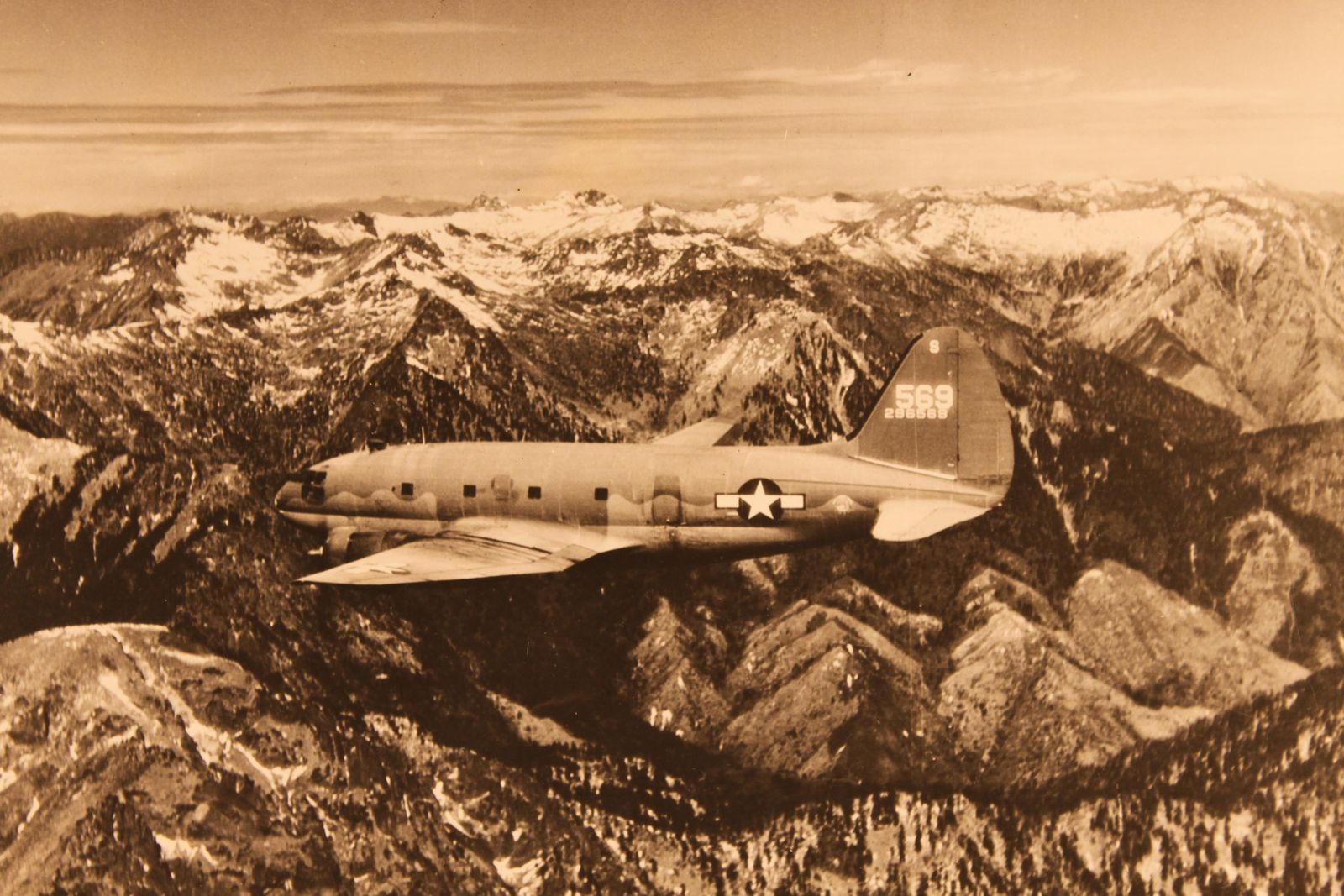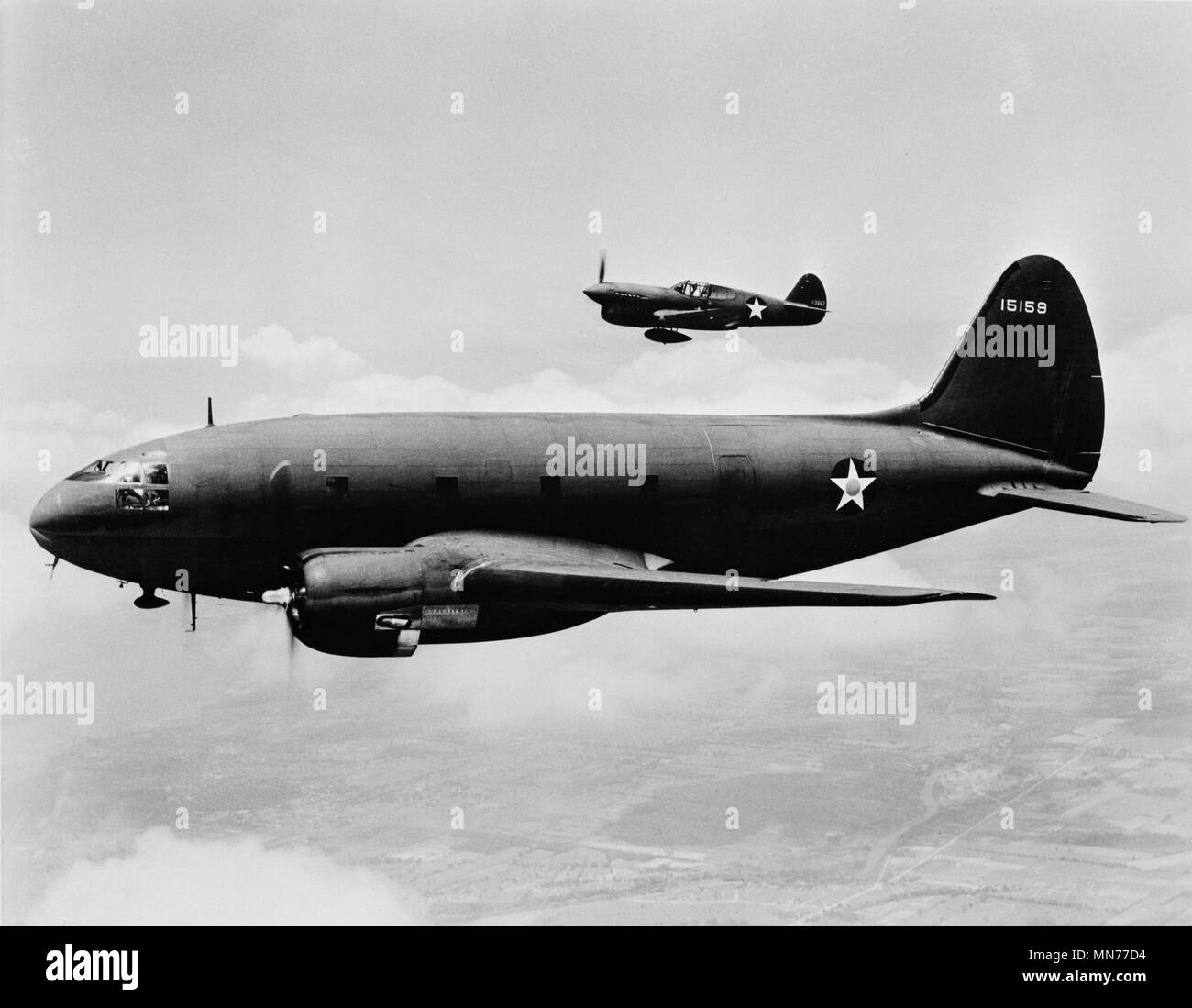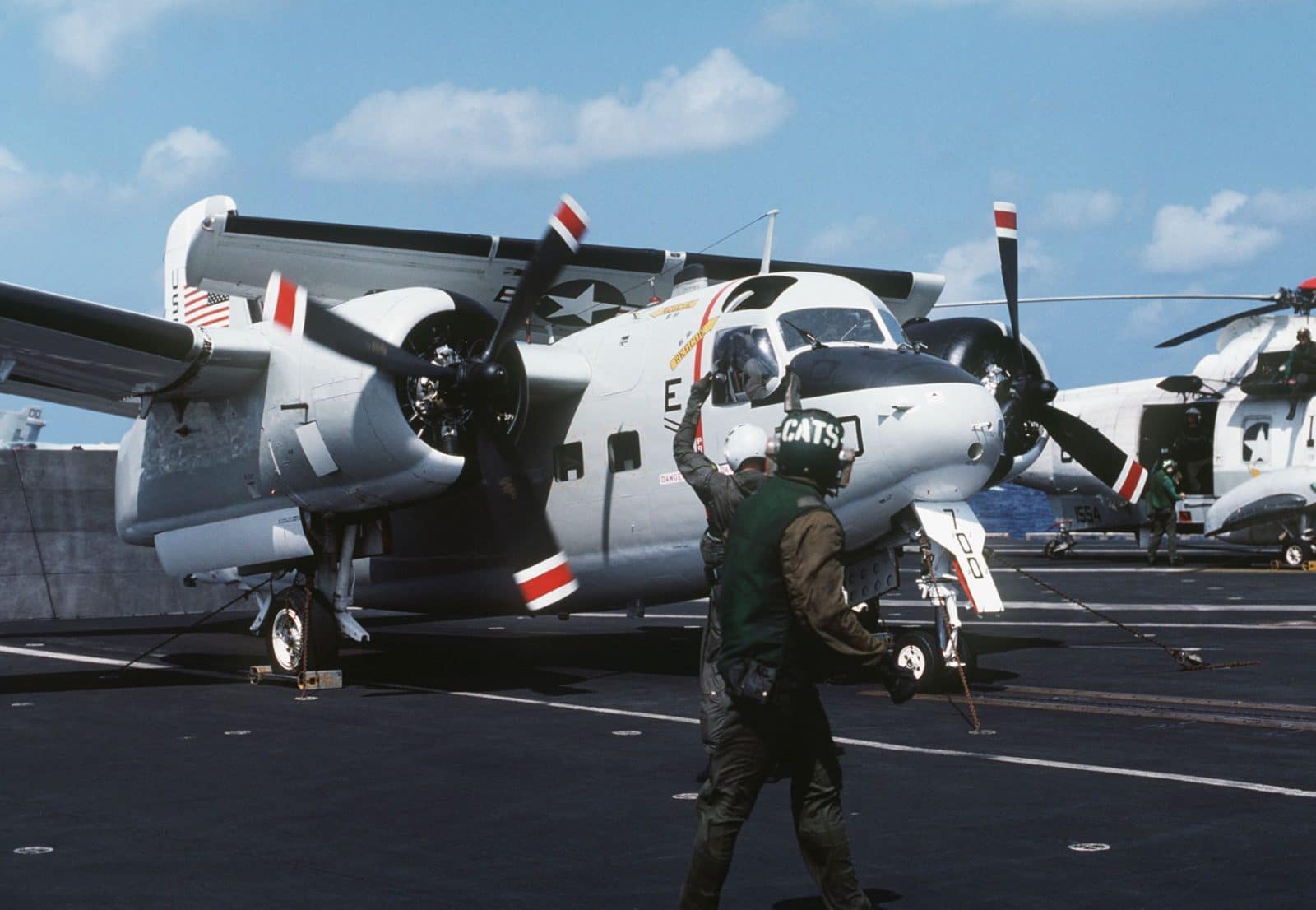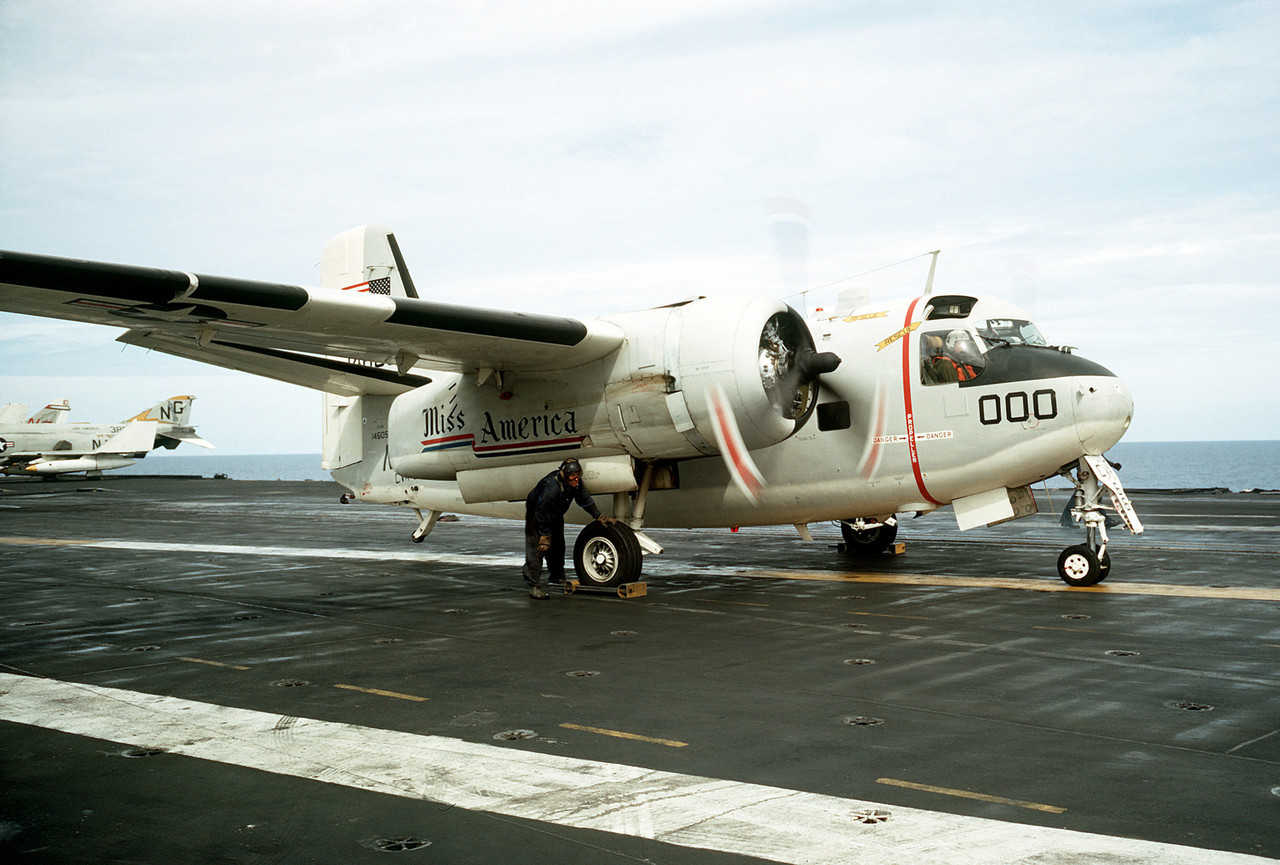C 46 Transport Aircraft - Unfortunately, the C-55 was a raw, unfinished prototype. The only substantive change Curtiss had made after initial flight testing was to replace the original twin tail with the Commando's big vertical fin and rudder; Eddie Allen had complained about low-speed stability and single-engine handling.
The Air Corps sent the C-55 back to Buffalo with a long list of needed fixes and mods, but Hap Arnold's demand for the design resulted in an order for 200 of what would become the C-46.
C 46 Transport Aircraft

The C-46's four-blade Curtiss electric props were also a hazard. The electrical contacts corroded in humid India, and the props would suddenly overspeed. "It was SOP during takeoff for the copilot to have his fingers on the toggle switches of the override system in case the props overspeeded," former Commando pilot Don Downie wrote in his excellent book Flying the Hump.
C-46s eventually got three-blade Hamilton-Standard propellers, and one of the main reasons there are so few Commandos still flying is that those huge props are today so rare as to be essentially irreplaceable. Curtiss originally designed the C-46 to be a pressurized luxury airliner with enough range to fly the golden route between New York and Chicago non-stop and above most of the weather.
It would be a 24- to 36-seat "sub-stratosphere transport," the company's marketers optimistically predicted, with the option of being configured with crosswise sleeping berths. But it would never be pressurized, never be luxurious, never be a true airliner.
At best, hundreds of war-surplus Commandos were operated in the late 1940s and early 50s by startup nonscheduled cargo and passenger carriers. Having cost the government $313,500 each, C-46s were sold as surplus for as little as $5,000.
During World War II there was little debate as to what was desired of a transport aircraft: it was one that was equally useful for the delivery of either cargo or troops to their destination. However, the only aircraft specifically developed during the war for this purpose was the Fairchild/North American C-82 Packet that did not see service until after the war.
Meanwhile, great resourcefulness was displayed in meeting emergency demands using the aircraft and equipment that was readily available. Those aircraft, forming the backbone of the Army Air Force's (AAF) transport fleets, were the C-47, C-54 and the C-46.
The Curtiss-Wright C-46 Commando was the military version of a yet unproven commercial transport. Like the C-47, it was a twin-engine monoplane but much larger and heavier with a maximum cargo capacity of 15,000 pounds against 10,000 for the C-47 and a passenger load capacity of 12,000 pounds against 6,500 for the C-47.
Accordingly, the Army Air Force (AAF) rested high hopes on its development but engineering difficulties so persisted that it did not get extensive use before 1944. Total acceptance reached only 3,144 airplanes by August 1945. The CW-20 prototype had a long aluminum fairing to hide the crease between the cabin and luggage compartment, but the extra metal weighed 275 pounds, added manufacturing complexity and did nothing aerodynamically.
It was quickly eighty-sixed, leaving the C-46's signature fuselage shape naked. Page was granted a design patent on the CW-20's configuration, much like Coca-Cola patenting the shape of its wasp-waisted bottle. It's unclear how Boeing circumvented the patent to create the double-bubble Model 377 Stratocruiser just five years later, although Boeing and Douglas designed the double-bubble 707 and DC-8 after the Curtiss patent had expired.
During WWII Hump operations, a C-46 notched its first air combat victory when Captain Wally Gayda stuck a Browning Automatic Rifle out his cockpit window and emptied the entire magazine at an attacking Nakajima Ki.43 Oscar.

Gayda hit the unsuspecting pilot, and the Oscar went down. During the Bay of Pigs operation, a C-46 scored the Commando's second "kill." Having dropped a load of doomed Cuban exile paratroopers, the transport was on its way back to the CIA's secret Guatemala base when it was attacked by one of Castro's Hawker Sea Furies.
Something went wrong, probably an overenthusiastic too-low, too-slow stall/spin, and the Hawker augured into the Caribbean, killing the pilot. WWII was far from the last of the C-46's wars. A number of Commandos became part of Chiang's Republic of China Air Force fighting Mao's Red Chinese, and several served with the French air force in Indochina, ultimately dropping supplies during the war-ending siege of Dien Bien Phu.
The Israeli Air Force flew Commandos during the Arab-Israeli war in 1948, carrying license-built Messerschmitt Avia S-199 fighters from Czechoslovakia to Israel via South America and North Africa. C-46s were active in the U.S. Air Force during the Korean War and in Vietnam, where one C-46, carrying 152 Vietnamese from Saigon to Bangkok, was the last fixed-wing aircraft to leave South Vietnam before the country was overrun.
The Commando was finally retired from the USAF in 1968, although it's possible that Reserve units continued using a few C-46s until as late as 1972. The airplane was also a maintenance hog, largely because of its leaky hydraulic system.
On Hump trips, savvy crew chiefs would carry along a 55-gallon drum of hydraulic fluid to ensure they'd have enough to top off the system during the China turnaround. Among its many other nicknames, the Commando was thus dubbed Leaky Tiki.
Because Curtiss assumed so big an airplane would require powered controls, it had hydraulic systems running the ailerons, elevator and rudder, as well as the landing gear and flaps. The control-boost systems were eventually removed, and the C-46 turned out to fly just fine without them.
Although at least one C-46 Hump pilot said that being assigned to a C-47 trip "was like driving a sports car"—words of praise that perhaps had never before or since been applied to the Gooney Bird.
Altitude performance was the key to the C-46's major contribution to World War II: It was the only high-altitude, heavy-lift cargo aircraft available to cross the Himalayas on the famous China-Burma-India Theater “Hump” route, airlifting supplies to Chiang Kai-Shek's army after the Japanese closed the Burma Road.
C-47s did yeoman work crossing what Hump pilots called the Rockpile, and eventually the four-engine C-54 would become the favored airlifter when Japanese retreats opened a lower-altitude Hump route. However, C-46s did the brunt of the Hump-topping work during the prime years of the resupply route.
The importance of the transport plane to the operations of the AAF, whether as a carrier, troop transport or long-range cargo carrier, was illustrated by the growing number of these planes. In July 1939, the AAF had only 118 transports and on the eve of Pearl Harbor it had only 216. After that, the inventory rose steadily and by August 1944 the AAF had more than 10,000 transports on hand.
In the 1920s and 30s, Curtiss was a single-engine fighter company, with a long line of biplane pursuits for the Army and Navy, and then the P-36 and P-40 Hawk fighters for the Army Air Corps and export.

The CW-20 Condor III was by far the largest and most complex design the company had ever undertaken. The other distinctive Commando feature that Page confirmed at Caltech was the airplane's double-bubble, figure-eight cross-section. The CW-20 was intended to be pressurized, to compete with the Boeing 307, the world's first pressurized airliner.
Curtiss also wanted the CW-20 to have a large, separate luggage compartment under the main cabin, an innovation for that era. To encompass both a roomy cabin and a supplementary cargo area within a single circular cross section—the ideal for pressurization—would have created a fuselage with a large frontal area and thus increased form drag.
So Page outlined a partial circle tied firmly into a wide floor to contain the passenger cabin, and a separate smaller ovoid area, attached to the floor from below, for the unpressurized baggage area. Among the bombers modified for transport service, the first choice fell on the Liberator B-24 because of its long range.
Designated the C-87 Liberator Express, the modified bomber performed important transport services for the AAF from the beginning to the end of the war. As the C-109, it was used as a tanker and hauled large quantities of fuel across the Himalayas from India to China.
Many unmodified B-24s saw unanticipated service as transports and tankers in theaters throughout the world; a notable example being the use of a wing of the Eighth Air Force's B-24s in September 1944 to haul gasoline for George Patton's Third Army in France.
The emblem is that of the First Troop Carrier Command. Its motto: VINCIT QUI PEIMUM GERIT means: "He conquers who gets there first". An original patch is part of the Museum's collection. It is hand painted on a leather disc.
It was sewn onto a leather jacket worn by a crew member. The first 25 C-46s delivered were simply CW-20s with a bare interior. The 26th included a momentous change: Gone were Curtiss' 1,700-hp Wright R-2600 Twin Cyclone engines, replaced by the finest, most reliable big radial ever built—Pratt & Whitney's 2,000-hp R-2800 Double Wasp.
With its two-stage supercharger, the R-2800 gave this first true Commando high-altitude capability appropriate for what was intended to be a pressurized airplane. The Douglas C-47 Skytrain was a military cargo version of the DC-3, a standby of the commercial airlines for a number of years before Pearl Harbor.
With other modifications the DC-3 became the C-53 Skytrooper, a troop and hospital transport. A steady and proven aircraft, the C-47 earned for itself a reputation hardly eclipsed even by the more glamorous of combat airplanes.
The dependable workhorse of the air, one found it everywhere shuttling freight or airborne troops. Before the war was over the AAF had accepted more than 10,000 DC-3 type airplanes which was nearly half of the transport planes it received between 1940 and 1945.
Historian Barbara Tuchman blames Madame Chiang Kai-Shek for the C-46's failures. "The Dragon Lady so incessantly pestered Roosevelt for more aircraft that he sent C-46s before they were ready," Tuchman wrote. One C-46 pilot quoted in Flying the Hump remembered "transporting an assorted load of Kotex for Madame Chiang and some good California wine for her husband."

This at a time when three American crewmen died for every thousand tons of cargo carried into China, on missions substantially more dangerous than bomber runs over Europe. When design of the Curtiss CW-20 airliner began in 1936, war was a distant threat to the non-interventionist United States, and the Douglas DC-3 had already demonstrated the possibility of serious commercial air travel.
The Doug had rendered obsolete the Boeing 247 and Curtiss' gawky 12-seat, retractable-gear Condor II biplane. Curtiss found itself looking at future competition from Boeing's four-engine 307 Stratoliner and the Douglas DC-4. A Commando typically flew the Hump with a crew of three—two pilots and a radio operator.
Despite numerous sources claiming that C-46s had flight engineers, there is no such position in the cockpit. Often a crew would also include a crew chief acting as a combined loadmaster and mechanic. Only a few C-46s served in Europe, most notably during Operation Varsity, the airdrop component of the Allied push across the Rhine River into Germany in late March 1945. During the assault, 19 of the 72 Commandos involved were shot down.
C-47s fared far better, since they had been fitted with self-sealing fuel tanks. The C-46s not only had standard metal tanks, they still suffered from wing-root fuel pooling problems. German flak lit them up at an unconscionable rate, and since many downed Commandos took with them full loads of paratroops, U.S.
Commander Maj. Gen. Matthew Ridgway decreed that C-46s were never again to carry aloft an 82nd Airborne trooper. I had a big laugh when I found that military gliders were being made by piano manufacturers ""' sounds a little incongruent.
I spent four years at Dover. At first I was an Air Policeman and walked the flight line under MATS aircraft. I was always part of the 95th Fighter Interceptor Squadron which was at Dover. I loved walking the flight line while my fellow mechanics were getting the F-106 repaired.
The result was noticeably less drag, but it was a pointless exercise. Curtiss had no time to develop a pressurization system in the midst of wartime demands, and after the war a lack of airline interest in a civilian version of the airplane left the company with no reason to do the work.
No CW-20 or C-46 was ever pressurized. Cargo operators loved the Curtiss Calamity's enormous cabin volume and heavy-lift capability, and the C-46 was largely responsible for the startup of Slick Airways, among others. Earl Slick bought 17 C-46s for $14,500 apiece—about $175,000 in 2016 dollars—and started using them to carry long lengths of oil-drilling pipe for Texas wildcatters.
Slick was soon the largest air freight carrier in the country. By that time war clouds loomed, and Curtiss parked the CW-20 in the back of its main Buffalo, N.Y., hangar while it ramped up production of P-40s for the British.
Legend has it that while touring aircraft manufacturing facilities in September 1940, Maj. Gen. Henry "Hap" Arnold visited Curtiss, saw the CW-20 and supposedly declared, "I want that airplane." Since by then the Air Corps had already bought the prototype and was testing it—under the designation of C-55—more likely that's when Arnold became aware of its cargo- and troop-carrying potential.
Curtiss' C-46 development ended in 1946, when Eastern Air Lines canceled its order for CW-20Es, a proposed Wright R-3350-powered passenger-carrying variant of the Commando. Eastern realized there were hundreds of cheap C-47s coming onto the surplus market, and the Gooneys could fly the short/medium-haul routes more efficiently than the fuel-hungry C-46.

This nevertheless gave Curtiss plenty of time to publish postwar magazine ads touting the proposed new airliner with beaming stewardesses saying, "That's why I'm for airlines that fly Commando!" We can only assume the young ladies kept their undies on.
South and Central American airlines also fancied the Commando, in countries where air carriers were the only real roads to the interior, where mountains abounded and where many airfields were high, short and primitive. That combination gave me my only opportunity to fly a C-46.
On a travel magazine assignment in Costa Rica in 1968, I found myself aboard a Lacsa (today called Avianca Costa Rica) C-46. I was a cocky new private pilot and sent a note to the cockpit announcing as much.
The captain not only invited me up front but slid out of his seat and invited me to fly awhile. I remember little of the experience other than that the semicircular control wheel was the size of a toilet seat.
Commandos also got a reputation for fuel line vapor-locking at altitude when a crew tried to switch tanks. The only solution was to descend and try a restart, which was hardly an option over the Himalayas.
Postwar civilian C-46s all had submersible electric fuel pumps installed in their tanks, to forcibly push fuel through a vapor bubble. Countless published sources list carburetor icing as a C-46 bugaboo during Hump operations, but this is a misnomer.
To a pilot, "carburetor icing" means internal obstruction of a carburetor by moisture-laden air that is suddenly supercooled by flow through the carb venturi, turning the humid air to ice. What Commandos actually encountered—and they frequently did over the Himalayas—was impact icing, or physical obstruction of the external carburetor air scoop by snow, sleet and supercooled rain.
Choke off a piston engine's induction air source and it's out of business. The only cure is rapid selection of "alternate air" from a secondary air inlet inside the warm engine nacelle, before the big Pratt dies.
Restarting a hot but dead R-2800 at 20,000 feet could be a challenge. In charge was a prolific engineer, George A. Page Jr., who ultimately directed 60 Curtiss designs. Page was a pioneer aviator, having soloed in 1913, and he even worked briefly as an airline pilot.
The Commando was the high point of his career. Page had his CW-20 design extensively tested in the 10-foot-diameter Guggenheim Aeronautical Laboratories wind tunnel at Caltech. Tunnel testing encouraged him to engineer unusual nacelles for what became the C-46, with cowl flaps only on the bottom half of the pods.
This avoided feeding any turbulent cooling airflow over the upper lifting surfaces of the wings. The Central Intelligence Agency was a long-time C-46 user, both in its false-front airlines—Air America and its predecessor, the Chinese Civil Air Transport (CAT)—as well as in a variety of clandestine operations.

The most notorious of these was the attempted Bay of Pigs invasion of Cuba, in April 1961. Those who remember the disastrous CIA operation will recall a motley crew of warbirds—T-33s, Sea Furys, B-26 Invaders—but few remember that
five C-46s were also an important part of the anti-Castro invasion. But the C-46 was nobody's favorite. Thirty-one of the 230 Commandos used on the Hump routes—more than 13 percent of the fleet—exploded in flight. It was long thought that 55-gallon drums of avgas cargo were the cause, and no matter how frigid the loaded eastbound flight to China, C-46 crews wouldn't touch the cockpit heater until they were returning to India empty, the cabin swept
clean of gas fumes. It was finally discovered that fuel from tiny leaks in the wing tanks and fuel lines pooled in the C-46's unvented wing roots, where a stray spark would eventually set it off.
After the war, all C-46s were modified with proper vents, sparkless fuel-boost pumps and shielded wing-area wiring. At the other end of the crew spectrum, C-46s were occasionally soloed over the Rockpile by especially experienced pilots.
All of the airplane's controls and systems were accessible from the left seat, unlike the C-47, which was soloed from the copilot's chair for easy access to the cowl flaps. The C-46 also had one thoughtful feature that greatly aided cargo-loading: The cabin floor just inside the large cargo door was level when the airplane was parked.
A forklift—or, as was sometimes the case in India, an elephant with a gasoline barrel wrapped in its trunk—was presented with a flat floor rather than the uphill tilt of a C-47. The Commando also had a particularly long tailwheel leg, to moderate the inclination of that uphill-when-parked floor.
Back in 1964 I was coming back from leave (Omaha) from boot camp. My uncle wrangled me a seat on a DC-3 (that is what I knew it as – the Air Force designation may have been different) out of Offut for the flight back to San Diego.
He was the navigator on the flight and a WW2 veteran. I was a lowly Naval E-2. I got called forward to have a few words with my uncle. The view was spectacular. Loved his control panel.
And all the other passengers were envious. An E-2? Gone are the days. The wind tunnel also verified one of the CW-20/C-46's most distinctive features—its streamlined, unstepped cockpit glazing, which gave the Commando its perfecto-cigar shape.
A small number of C-46s were built with conventional windshields; they were known as broken-nose commandos.
c 46 cargo plane, c46, curtiss c 46 commando, commando airplane, curtiss c 46 commando specifications, c 46 aircraft for sale, c 46 commando aircraft, c 47 aircraft

![]()

![]()






